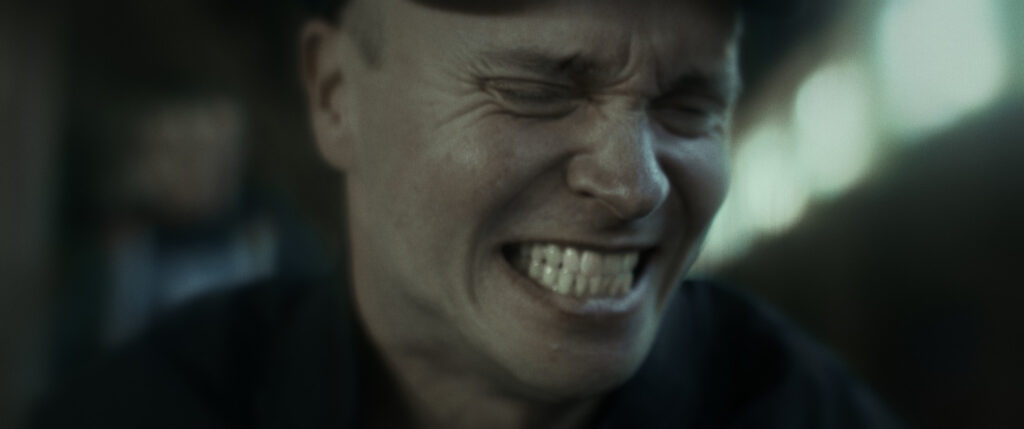The Cinematic Language of Disability
Teemu Nikki’s romantic thriller is equal parts visual experiment and riveting narrative. A still from "The Blind Man Who Did Not Want To See Titanic", dir. by Teemu Nikki / Photo by Cinedigm.
A still from "The Blind Man Who Did Not Want To See Titanic", dir. by Teemu Nikki / Photo by Cinedigm.
The Blind Man Who Did Not Want to See Titanic
Dir. Teemu Nikki
Streaming March 14 on Fandor and Amazon Prime
Few filmmakers have used the moving camera to achieve what writer-director Teemu Nikki and cinematographer Sari Aaltonen have in The Blind Man Who Did Not Want To See Titanic. A focused romance quest and character piece, the 2021 independent Finnish production follows wheelchair-using film enthusiast Jaakko Järvinen (Petri Poikolainen). His failing eyesight and multiple sclerosis have left him largely homebound, but his phone conversations with a chronically ailing woman, Sirpa (Marjaana Maijala), offer him daily pep and put a smile on his face. The movie’s casting and writing avoid the familiar traps related to gawking at disabled people; and the role was written for Poikolainen, who shares Jaakko’s disability. His energy goes less toward impersonating his physicality and more to rounding out his character as fun, prickly and self-effacing.
There are few moments when the camera isn’t affixed to Poikolainen’s expressive countenance. The rest of the physical world fades out of focus, yielding a magnetic form of experiential cinema that over the course of the story becomes downright heart-pounding.
For Jaakko, each repetitive day begins by jolting himself awake from dreams of running. For these scenes, Nikki skillfully obscures Poikolainen’s body. Jaakko is fairly well-adjusted to his painful routine of slipping into his chair and wheeling it about his home, and dialing his voice-activated phone. But mobility and freedom aren’t one and the same, because the world around him remains hostile towards disability. As much as he might want to visit Sirpa — who he met on an online forum, and who lives several hours away by train — the journey would be harrowing without other people’s aid. The film, therefore, spends a significant chunk of its 82-minute runtime on Jaakko’s phone conversations: his flirtations with Sirpa and his less enthused (and even resentful) phone calls with his parents, who also live far away, and whose concerned questions he quickly shuts down.
The movie’s visual fabric, composed largely of soft-focus close ups, applies an experimental and even impressionistic lens to its fairly straightforward story of a man longing for a woman despite circumstances that prevent them from being together. It reveals the intricacies of Jaakko’s character through his self-professed cinephilia, a passion he no longer avails, but which makes up a significant part of his personality. He has his artistic likes and dislikes, and he subtly condescends to anyone who feels otherwise (including Sirpa, though he disguises his disagreements with her as tongue-in-cheek teasing). His enormous shelf of DVDs is an epitaph to the man he used to be, the man he was flash-frozen as when his eyesight failed him. His copy of James Camerson’s Titanic — a favorite — remains neatly shrink-wrapped. Whether or not he would have watched it, he now claims a conceptual distaste for the action maestro’s most famous romance. It’s as if he has no choice but to concoct excuses to remain in emotional stasis and continue snapping at those around him (such as his parents and the caretaker who stops by for an hour a day). However, when Sirpa’s health suddenly declines, Jaakko sets out to visit her against all odds, Titanic DVD in hand, as if meeting her in person, and experiencing her favorite movie together, will offer some chance at absolution.
The movie’s visual fabric, composed largely of soft-focus close ups, applies an experimental and even impressionistic lens to its fairly straightforward story
Two cabs and a train ride: that’s all it would take for him to unite with the woman he loves. However, unassisted, it’s a Herculean task that may as well be a global scavenger hunt. Jaakko must depend on other people’s kindness when he himself is often unkind. He also is easy to take advantage of, which transforms this tale of romantic longing into a riveting thriller when he is cornered by people whose empathy he requires to survive. He depends mostly on sound and physical texture to navigate the world, and the film complements its detailed frame — presenting a litany of out-of-focus but instantly recognizable details — with a deftly defined soundscape whose many layers we experience in a deconstructed form that shifts the way our blind protagonist might interpret the world after years of depending on his other senses.
Within traditional cinema — a medium that prioritizes clarity and continuity — The Blind Man Who Did Not Want To See Titanic is an experimental curio. On the surface, it evokes Julian Schnabel’s 2007 wonder Le Scaphandre et le Papillon (The Diving Bell and the Butterfly), which is told from the perspective of a paralyzed stroke victim who communicates with only his eyes. To tell that story, Schnabel and cinematographer Janusz Kamiński employed tilt-shift lenses and even Schnabel’s own reading glasses to distort the physical world and embody Bauby’s shifting gaze. Though Nikki’s film uses no such tricks to curve the light — Jaakko’s perspective is unchanging — it is similarly constrained in its use of point of view. It particularly departs from Diving Bell by robbing the viewer of reverse shots and the comfort of seeing other characters’ faces, through which we (and Jaakko) might be able to discern their motives. Therefore not only does Nikki’s visual approach create a visual embodiment of the nonvisual, it does so in a way that serves the story by obscuring what might otherwise seem obvious to sighted viewers.

While this embodiment is expert in its re-creation of new cinematic sensations, it occupies a paradoxical space. Cinema is traditionally an audio-visual medium whose language caters to sighted and hearing audiences, so this film’s very existence as a visual marvel about a blind character becomes inherently dilemmatic. The same can be said of many films about deaf and hard-of-hearing characters, including Best Picture Oscar winner CODA or its recent experimental cousin The Tuba Thieves, which involve bringing hearing viewers into the deaf experience, often with unconventional use of sound. This often leads to the question of whether the established molds of cinematic language can ever be made to cater primarily (or even largely) to disabled viewers, rather than having them rely on captions or audio descriptions.
Nikki’s The Blind Man may well be one of the rare movies that approaches this cinematic ideal, even if it doesn’t fully achieve it. Whether or not this was its primary aim is certainly in question. It begins with opening credits calligraphed in Braille and narrated by automatic voice generation, so placing viewers in the perspective of disability while also catering to it is certainly part of its purview. But if this duality — of being both about and for the disabled — is a pragmatic ideal, then the film’s subsequent execution does bring it a small step closer. Much of the storytelling rests on Poikolainen’s deeply empathetic performance, shifting between physical expressions that balance repressed anguish and discomfort with an outwardly boisterous attitude. Just as important is his equally empathetic voice-acting, which achieves the same, perhaps in subtler ways. Each of Jaakko’s thoughts and considerations, as he navigates thorny scenarios, is expressed through a prism of self-defeat. For instance, he tries to convince a mugger that as a poor disabled person, he has nothing to offer him. This creates intriguing dramatic questions of whether this is simply deception or a reluctant expression of truth. Poikolainen frequently keeps us guessing. His performance is so fine-tuned that the answer may be “both.”

Poikolainen’s performance, coupled with the aforementioned soundscape detailing the world around Jaakko as he moves through it, creates a scenario where even sighted viewers might be tempted to close their eyes or momentarily look away from Nikki’s gorgeous and precise visual composition. The camera’s dance with Poikolainen’s close-ups is so effective at placing the viewer almost completely within Jaakko’s perspective, that the frame may as well be offering subliminal commands to complete the process. The picture is so enrapturing that it makes one wonder what lies beyond it.
Certainly, some additional detail is lost in closing one’s eyes. When a stranger waves his hands in front of Jaakko’s face to confirm his blindness, for instance, it creates momentary tension by introducing danger that is known to sighted viewers but unknown to Jaakko. However, Nikki’s command of aural language, whether portraying the bustling movement of urban environments or the eerie stillness of isolation, ensures that his movie remains something worth experiencing even without the picture — something very few films can boast as a positive.
Even sighted viewers might be tempted to close their eyes or momentarily look away from Nikki’s gorgeous and precise visual composition.
In a twist of ironic timing, the movie’s limited February theatrical run in the United States ended the day Titanic received its national re-release. And while the comparison between the two films initially yields a David-and-Goliath dynamic — a scrappy independent production vs. an enormous, VFX-heavy studio picture — the two films are far more similar than one might expect (and certainly more similar than a character as jaded as Jaakko might be willing to admit). Both films center nigh-impossible romances against technological backdrops, with characters the entire world seems dead-set against. Both films use their respective traditional and nontraditional framing to lure empathy even from the most hardened viewers once things go awry.
If anything, Titanic, and Jaakko’s refusal to watch it, end up being the Rosetta Stone to his story. The English translation of the movie’s title cites his reluctance not as a refusal to watch Cameron’s movie, but to see it, which initially seems like a cruel irony given his disability. But it quickly reveals itself to be prescient, given his unwillingness to open himself up to other people’s experiences after being so hardened by his own.
Your support matters…Independent journalism is under threat and overshadowed by heavily funded mainstream media.
You can help level the playing field. Become a member.
Your tax-deductible contribution keeps us digging beneath the headlines to give you thought-provoking, investigative reporting and analysis that unearths what's really happening- without compromise.
Give today to support our courageous, independent journalists.






You need to be a supporter to comment.
There are currently no responses to this article.
Be the first to respond.